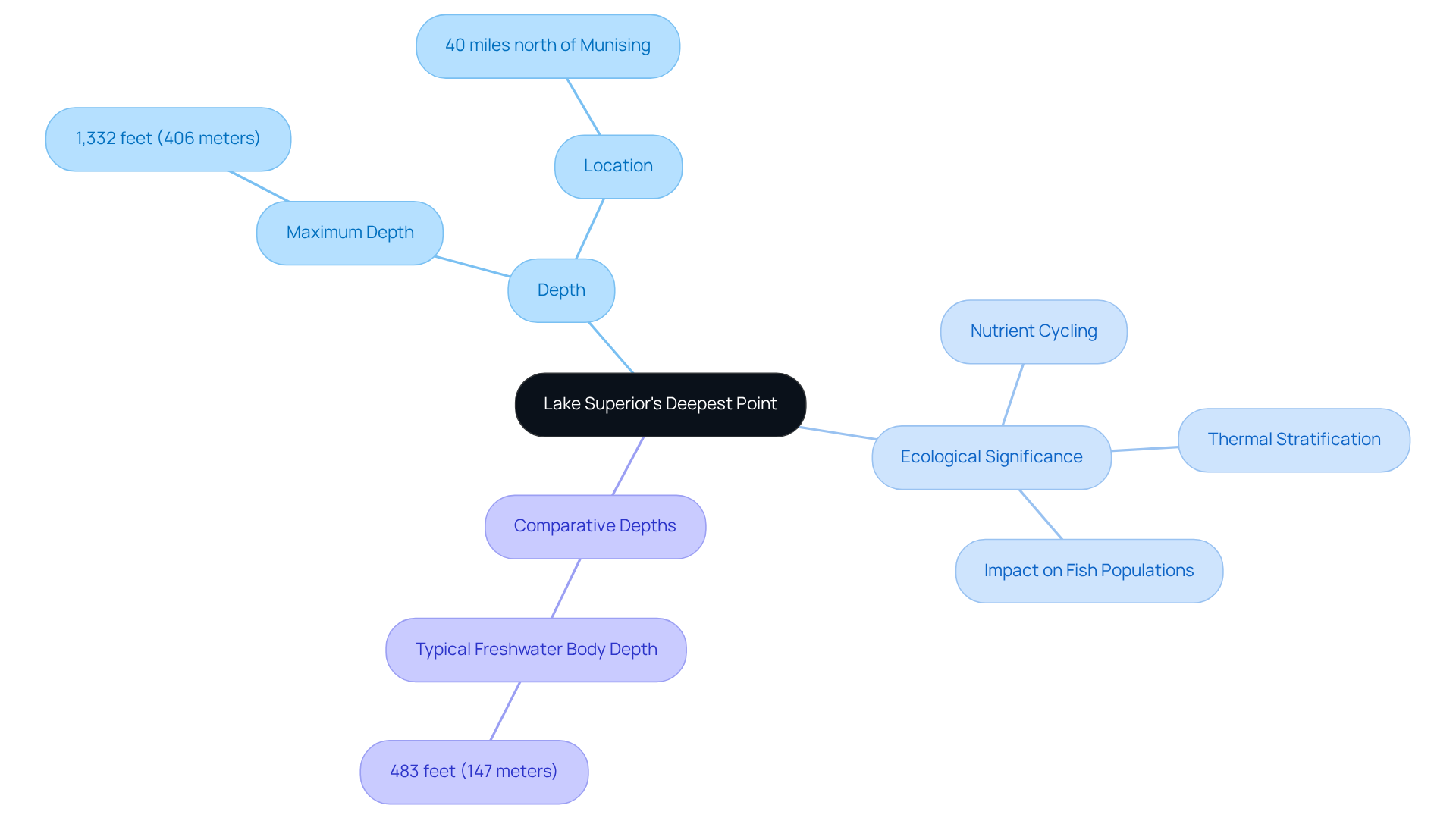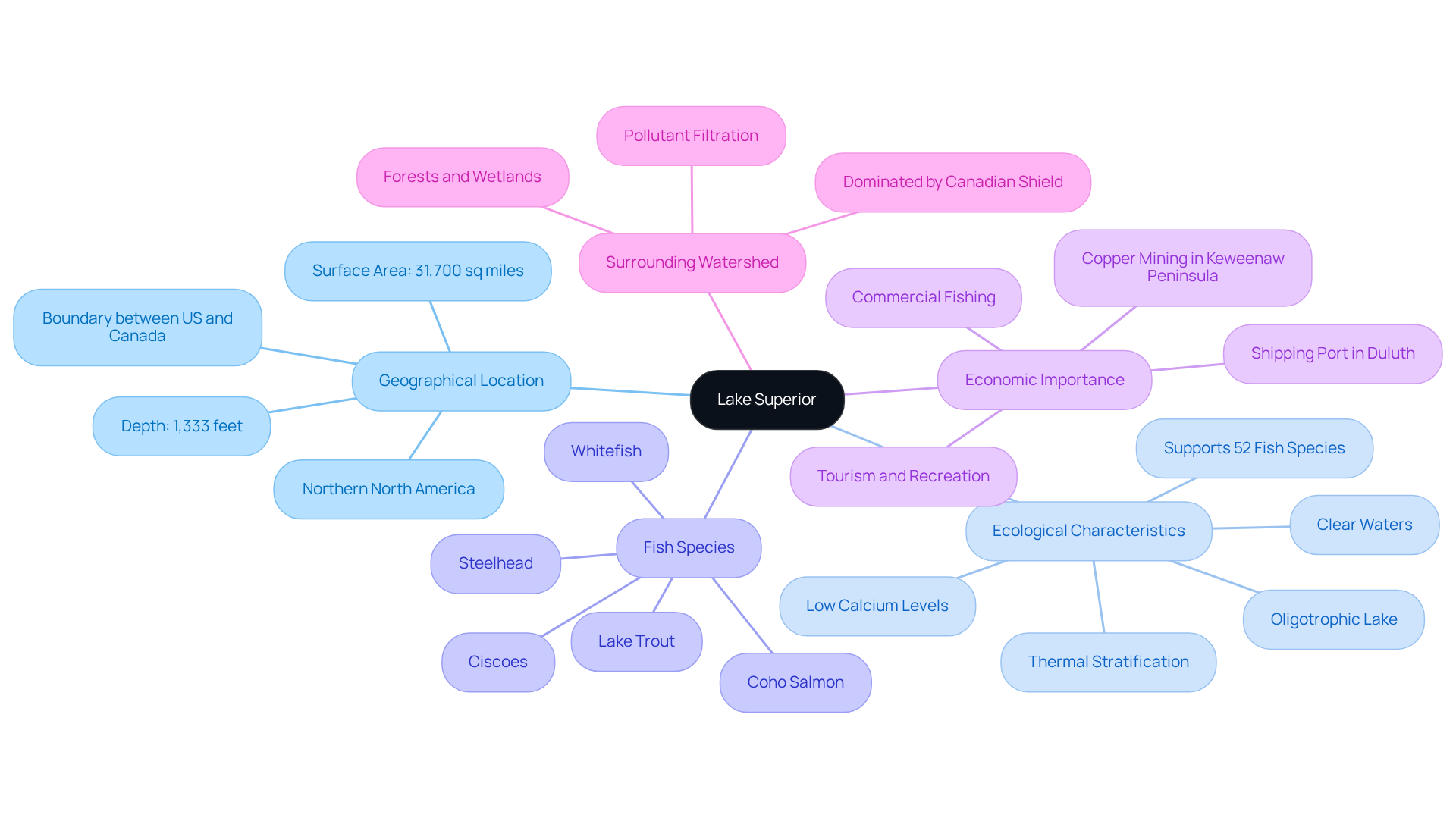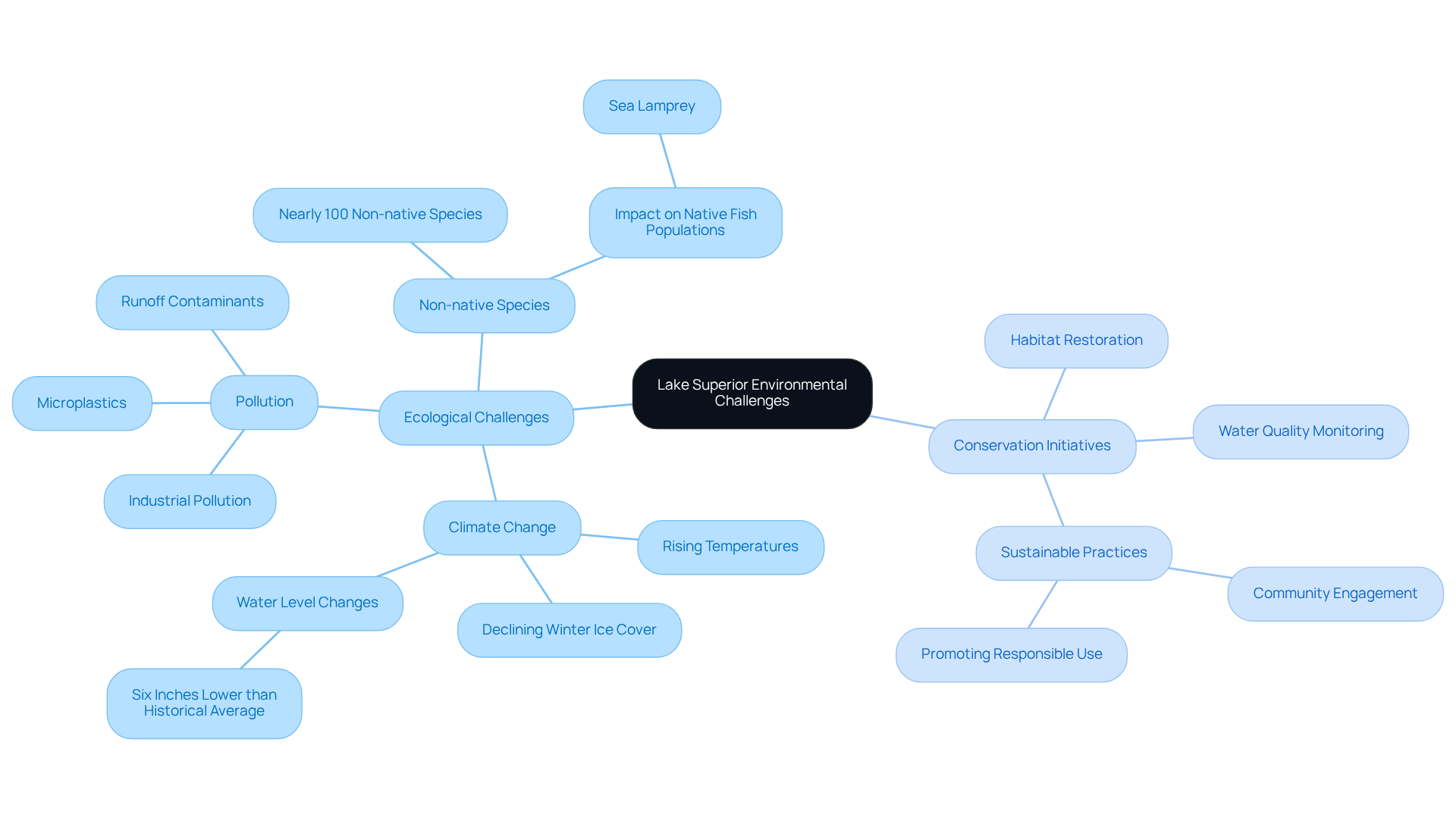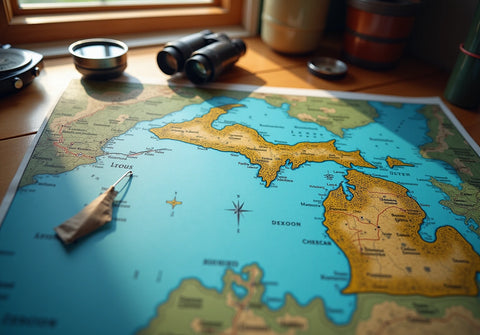Overview
Lake Superior's deepest point, situated approximately 40 miles north of Munising, Michigan, plunges to an impressive depth of 1,332 feet. This remarkable depth not only establishes it as the deepest point among the Great Lakes but also underscores its importance as a crucial ecological resource. Such significant depth plays a pivotal role in various ecological processes, including:
- Thermal stratification
- Nutrient cycling
These processes are vital for sustaining the lake's health and supporting its diverse aquatic life.
Introduction
Lake Superior, the largest freshwater lake by surface area, stands as a geological marvel among the Great Lakes, with a remarkable depth of 1,332 feet. This profound depth shapes the lake's unique ecological dynamics and serves as a critical resource for understanding climate change and conservation efforts.
As environmental challenges mount, it is imperative to consider how we will safeguard the future of this vital waterway. What actions can we take to preserve its rich history and ecological integrity for generations to come?
Define Lake Superior's Deepest Point
The deepest point of Lake Superior, situated about 40 miles north of Munising, Michigan, attains an impressive depth of 1,332 feet (406 meters). This depth not only establishes it as the lake superior deepest point among the Great Lakes but also as the largest freshwater body by surface area globally. It holds an astounding volume of 2,900 cubic miles (12,100 km³) of water, enough to inundate all of North and South America with water one foot deep.
The significance of this depth is profound, influencing various ecological and hydrological processes within the lake, including thermal stratification and nutrient cycling. To provide context, the typical depth of the largest freshwater body is 483 feet, underscoring the exceptional nature of Lake Superior's maximum depth.
The lake Superior deepest point, often referred to as the 'bottom' of the lake, serves as a site for studying geological features and sedimentation patterns, which are crucial for understanding the history and environmental changes of the lake over time. Recent studies highlight that the depth of this vast freshwater lake significantly influences its ecological dynamics, affecting everything from fish populations to water quality.
As Dan Bevilacqua, Executive Director of Ontario’s Superior Country, aptly states, 'Comprehending the depth and ecological importance of this great body of water is essential for promoting and conserving this remarkable natural resource.' Understanding these connections is vital for conservation initiatives and effectively managing the water body's resources.

Explore the Geographical and Ecological Context
The large body of water, known as Lake Superior, is situated in the northern region of North America, spanning the boundary between the United States and Canada. With a vast surface area of approximately 31,700 square miles (82,100 square kilometers) and featuring Lake Superior's deepest point at 1,333 feet (406 meters), it creates a unique ecological environment.
This oligotrophic lake, characterized by low nutrient levels, contributes to its exceptionally clear waters and supports a diverse range of cold-water fish species, including lake trout and whitefish. Notably, Superior contains more liquid than all the other Great Lakes combined, underscoring its significance as a freshwater resource.
It supports 52 fish species, fewer than any other Great Lake, which is crucial for understanding its ecological dynamics. The lake superior deepest point plays a vital role in thermal stratification, affecting temperature and oxygen levels, which in turn influences fish populations and aquatic organisms.
The surrounding watershed, characterized by forests and wetlands, is instrumental in filtering pollutants and providing essential habitats for wildlife, further enhancing the area's ecological health. Additionally, the lake's low calcium levels hinder the establishment of significant populations of invasive quagga mussels, thereby supporting its ecological equilibrium.
The economic importance of Lake Superior is also noteworthy, particularly in relation to commercial fishing and its role as a shipping port in Duluth, impacting local economies. In summary, Lake Superior is an indispensable resource for both ecological balance and economic activity in the region.

Examine Historical and Cultural Significance
Lake Huron has long been a vital resource for indigenous peoples, particularly the Ojibwe tribes, serving as a source of nourishment, transit, and cultural identity for millennia. Historically, it functioned as a crucial route for fur traders and European explorers, significantly shaping the region's economic landscape. The name 'Lake Superior,' derived from the French phrase 'le lac supérieur,' meaning 'the upper lake,' signifies both its geographical location and its historical importance. Notably, this expansive body of water was a major transportation route for the fur industry during the Colonial period, underscoring its economic significance.
The cultural impact of Lake Superior on the Ojibwe tribes is profound. It is not merely a source of food and livelihood but also a central element of their spiritual and cultural practices. Phillip Solomon, an Anishinaabe fisherman, emphasizes the changing conditions of the lake due to climate change, noting how warming waters and reduced ice coverage—averaging 53%—have altered traditional fishing practices. This shift highlights the urgent need for Indigenous stewardship to protect the lake's resources and cultural heritage.
Furthermore, the Ojibwe tribes' deep-rooted connection to Lake Superior is reflected in their stories, traditions, and environmental practices. The lake is home to approximately 80 species of fish, integral to their cultural narratives and sustenance. Its average underwater visibility of 27 feet (8.2 meters) illustrates its ecological health and clarity, both of which are vital to the Ojibwe's cultural values. As the lake continues to inspire artists, writers, and environmentalists, it symbolizes the natural beauty and cultural heritage of the Great Lakes region, reinforcing the importance of preserving its ecological integrity for future generations.

Analyze Environmental Implications and Conservation Efforts
Lake Superior, the largest freshwater body, confronts significant ecological challenges, including climate change, pollution, and non-native species. Rising temperatures have altered the quality of aquatic environments and disrupted fish populations, while intensified storms contribute runoff that introduces harmful contaminants into the aquatic system. Importantly, Lake Superior holds 10 percent of the world's available surface freshwater, highlighting the critical need for robust conservation initiatives.
Temperatures have increased by 2.5 degrees Celsius from 1979 to 2006, alongside the presence of nearly 100 non-native species, further underscoring the urgency for proactive measures to protect the ecosystem's integrity. Conservation initiatives are vital for ensuring the lake's health, with various organizations actively involved in:
- Habitat restoration
- Water quality monitoring
- The promotion of sustainable practices
For instance, the Great Lakes Collaborative is dedicated to preserving the watershed and encouraging community engagement in conservation efforts. By instilling a sense of responsibility, these initiatives strive to ensure that this vast freshwater resource remains pure and indispensable for future generations.
Furthermore, it is crucial to recognize that Lake Superior is currently six inches lower than its historical average, reflecting the ongoing effects of climate change on water levels.

Conclusion
The profound significance of Lake Superior's deepest point transcends mere measurements; it embodies the intricate relationship between depth, ecology, and cultural heritage. This remarkable freshwater body, with its staggering depth of 1,332 feet, not only stands as the deepest point among the Great Lakes but also plays a pivotal role in shaping the ecological and cultural landscape of the region.
Exploring Lake Superior's depths reveals key insights regarding its ecological dynamics, historical relevance, and the pressing need for conservation efforts. The lake's unique oligotrophic nature fosters a diverse aquatic ecosystem, while its historical significance to Indigenous peoples underscores the deep cultural ties that bind communities to this vital resource. Moreover, the challenges posed by climate change and pollution highlight the urgency for sustainable practices and community engagement in preserving this irreplaceable freshwater resource.
Ultimately, recognizing the importance of Lake Superior's deepest point is essential for fostering stewardship and responsibility towards its preservation. As environmental challenges mount, proactive conservation initiatives become critical to maintaining the health of this remarkable ecosystem. The collective efforts to protect Lake Superior not only safeguard its natural beauty and biodiversity but also honor the cultural heritage intertwined with its waters, ensuring that future generations can continue to cherish and benefit from this extraordinary natural wonder.
Frequently Asked Questions
What is the deepest point of Lake Superior?
The deepest point of Lake Superior reaches a depth of 1,332 feet (406 meters).
Where is the deepest point of Lake Superior located?
It is situated about 40 miles north of Munising, Michigan.
How does Lake Superior's depth compare to other freshwater bodies?
Lake Superior's depth of 1,332 feet makes it the deepest point among the Great Lakes and significantly deeper than the typical depth of the largest freshwater body, which is 483 feet.
What is the volume of water contained in Lake Superior?
Lake Superior holds an astounding volume of 2,900 cubic miles (12,100 km³) of water.
What ecological and hydrological processes are influenced by Lake Superior's depth?
The depth influences thermal stratification and nutrient cycling within the lake, which are crucial for its ecological dynamics.
Why is the deepest point of Lake Superior significant for research?
It serves as a site for studying geological features and sedimentation patterns, which are important for understanding the lake's history and environmental changes.
How does the depth of Lake Superior affect its ecological dynamics?
The depth significantly influences factors such as fish populations and water quality within the lake.
What is the importance of understanding Lake Superior's depth and ecology?
Comprehending the depth and ecological importance is essential for promoting and conserving this natural resource, as highlighted by Dan Bevilacqua, Executive Director of Ontario’s Superior Country.


